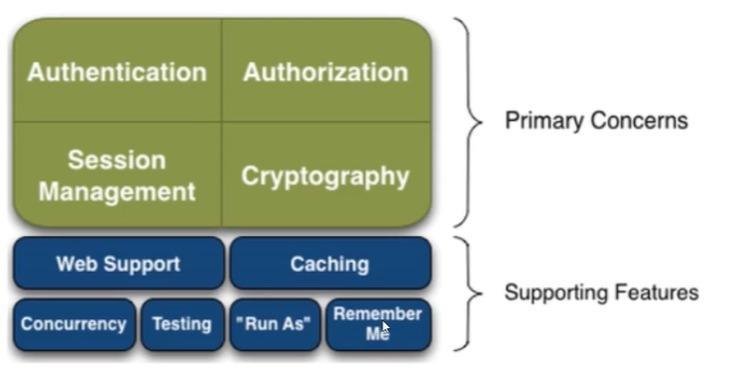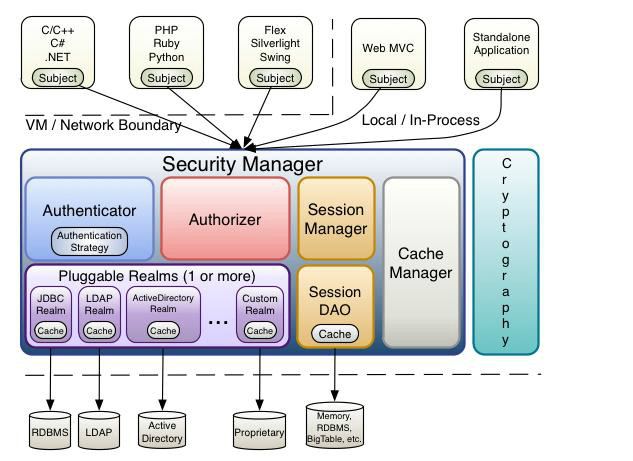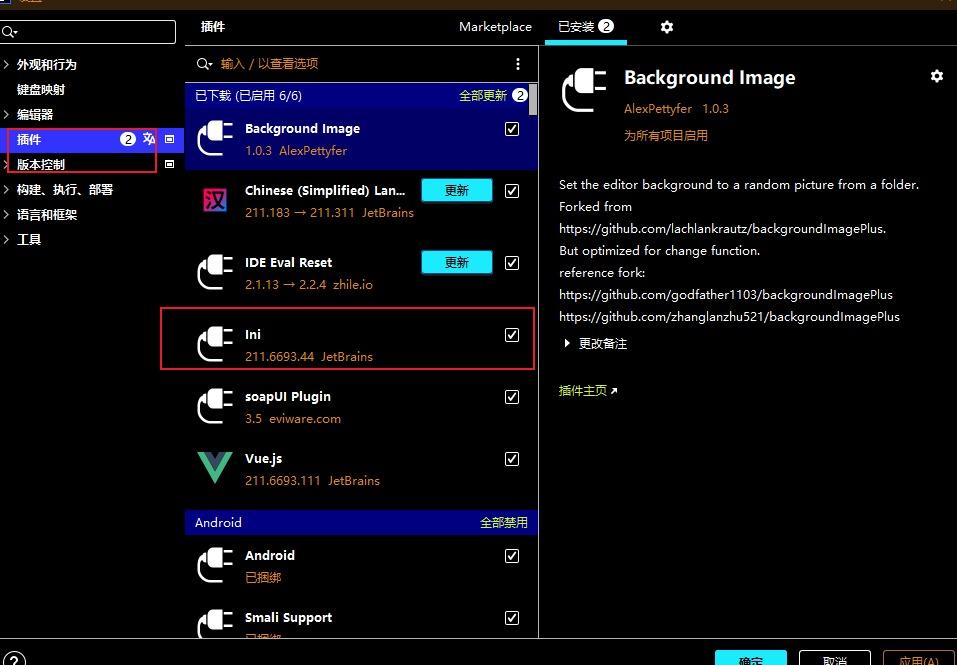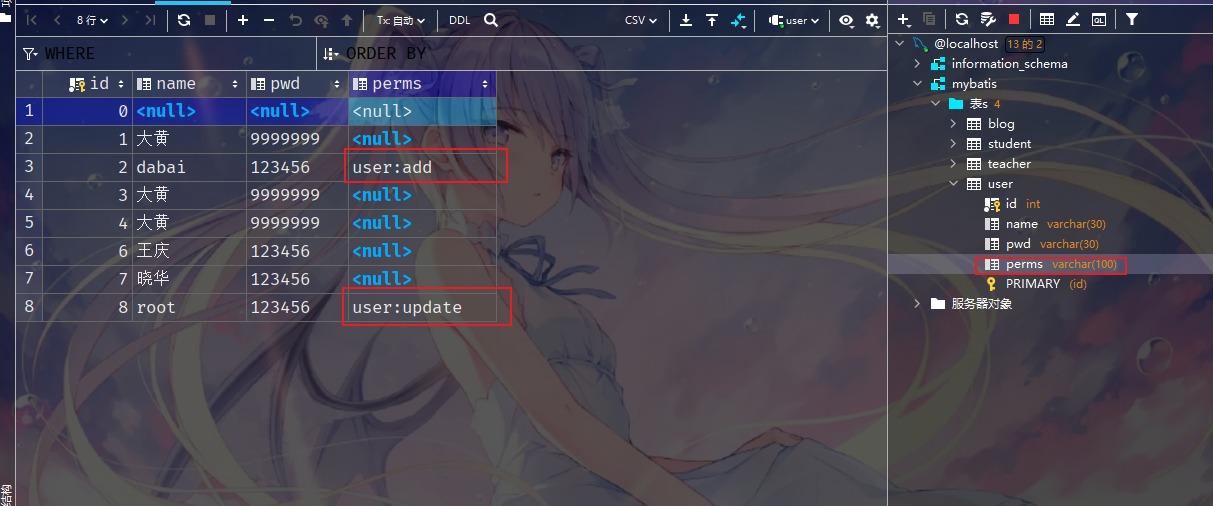SpringBoot微服务开发——Shiro(安全)
文章目录
Shiro(安全)
1、Shiro简介
Apache Shiro是一个强大且易用的Java安全框架,执行身份验证、授权、密码和会话管理。使用Shiro的易于理解的API,您可以快速、轻松地获得任何应用程序,从最小的移动应用程序到最大的网络和企业应用程序。
Shiro可以非常容易的开发出足够好的应用,不仅可以用在JavaSE环境,也可以用在JavaEE环境。
下载地址: http://shiro.apache.org/
2、Shiro有哪些功能?

- Authentication: 身份认证、登录,验证用户是不是拥有相应的身份;
- Authorization:授权,即权限验证,验证某个已认证的用户是否拥有某个权限,即判断用户能否进行什么操
- 作,如:验证某个用户是否拥有某个角色,或者细粒度的验证某个用户对某个资源是否具有某个权限!
- Session Manager:会话管理,即用户登录后就是第一次会话,在没有退出之前,它的所有信息都在会话中;
- 会话可以是普通的avaSE环境,也可以是Web环境;
- Cnyptography: 加密,保护数据的安全性,如密码加密存储到数据库中,而不是明文存储;
- Web Support: Web支持,可以非常容易的集成到Web环境;
- Caching: 缓存,比如用户登录后,其用户信息,拥有的角色、权限不必每次去查,这样可以提高效率
- Concurrency: Shiro支持多线程应用的并发验证,即,如在一个线程中开启另一 个线程,能把权限自动的传
播过去 - Testing:提供测试支持;
- Run As: 允许一 个用户假装为另- -个用户(如果他们允许)的身份进行访问;
- Remember Me:记住我,这个是非常常见的功能,即一次登录后,下次再来的话不用登录了
3、Shiro架构(外部)

- subject: 应用代码直接交互的对象是Subject, 也就是说Shiro的对外API核心就是Subject, Subject代表了当
前的用户,这个用户不-定是一个具体的人, 与当前应用交互的任何东西都是Subject,如网络爬虫,机器人
等,与Subject的所有交互都会委托给SecurityManager; Subject其实是一 个门面, SecurityManageer 才是
实际的执行者 - SecurityManager: 安全管理器,即所有与安全有关的操作都会与SercurityManager交互,并且它管理着所有
的Subject,可以看出它是Shiro的核心,它负责与Shiro的其他组件进行交互,它相当于SpringMVC的
DispatcherServlet的角色 - Realm: Shiro从Realm获取安全数据 (如用户,色,权限),就是说SecurityManager 要验证用户身份,
那么它需要从Realm获取相应的用户进行比较,来确定用户的身份是否合法;也需要从Realm得到用户相应的
角色、权限,进行验证用户的操作是否能够进行,可以把Realm看成DataSource;
4、Shiro架构(内部)

- Subject: 任何可以与应用交互的"用户;3
- Security Manager:相当于SpringMVC中的DispatcherServlet;是Shiro的心脏,所有具体的交互都通过
- Security Manager进行控制,它管理者所有的Subject,且负责进行认证,授权,会话,及缓存的管理。
- Authenticator: 负责Subject认证,是一一个扩 展点,可以自定义实现;可以使用认证策略(AuthenticationStrategy),即什么情况下算用户认证通过了;
- Authorizer:授权器,即访问控制器,用来决定主体是否有权限进行相应的操作;即控制着用户能访问应用中
的那些功能; - Realm: 可以有一个或者多个的realm,可以认为是安全实体数据源,即用于获取安全实体的,可以用DBC实
现,也可以是内存实现等等,由用户提供;所以- -般在应用中都需要实现自己的realm - SessionManager: 管理Session生命周期的组件,而Shiro并不仅仅可以用在Web环境,也可以用在普通的
JavaSE环境中 - CacheManager: 缓存控制器,来管理如用户,角色,权限等缓存的;因为这些数据基本上很少改变,放到缓
存中后可以提高访问的性能; - Cryptography:密码模块, Shiro 提高了一些常见的加密组件用于密码加密, 解密等
5、进入实践
打开官网文档: http://shiro.apache.org//tutorial.html
- 创建一个普通的maven父工程
- 创建一个普通的Maven子工程: shiro-01-helloworld
- 根据官方文档,我们来导入Shiro的依赖
1、导入依赖
<dependencies>
<!-- https://mvnrepository.com/artifact/org.apache.shiro/shiro-core -->
<dependency>
<groupId>org.apache.shiro</groupId>
<artifactId>shiro-core</artifactId>
<version>1.8.0</version>
</dependency>
<!-- configure logging -->
<dependency>
<groupId>org.slf4j</groupId>
<artifactId>jcl-over-slf4j</artifactId>
<version>1.7.21</version>
</dependency>
<dependency>
<groupId>org.slf4j</groupId>
<artifactId>slf4j-log4j12</artifactId>
<version>1.7.21</version>
</dependency>
<!-- https://mvnrepository.com/artifact/org.apache.logging.log4j/log4j-core -->
<dependency>
<groupId>org.apache.logging.log4j</groupId>
<artifactId>log4j-core</artifactId>
<version>2.14.1</version>
</dependency>
</dependencies>
2、配置文件
resources目录下
log4j.properties
log4j.rootLogger=INFO, stdout
log4j.appender.stdout=org.apache.log4j.ConsoleAppender
log4j.appender.stdout.layout=org.apache.log4j.PatternLayout
log4j.appender.stdout.layout.ConversionPattern=%d %p [%c] - %m %n
# General Apache libraries
log4j.logger.org.apache=WARN
# Spring
log4j.logger.org.springframework=WARN
# Default Shiro logging
log4j.logger.org.apache.shiro=INFO
# Disable verbose logging
log4j.logger.org.apache.shiro.util.ThreadContext=WARN
log4j.logger.org.apache.shiro.cache.ehcache.EhCache=WARN
shiro.ini,需要安装ini插件

[users]
# user 'root' with password 'secret' and the 'admin' role
root = secret, admin
# user 'guest' with the password 'guest' and the 'guest' role
guest = guest, guest
# user 'presidentskroob' with password '12345' ("That's the same combination on
# my luggage!!!" ;)), and role 'president'
presidentskroob = 12345, president
# user 'darkhelmet' with password 'ludicrousspeed' and roles 'darklord' and 'schwartz'
darkhelmet = ludicrousspeed, darklord, schwartz
# user 'lonestarr' with password 'vespa' and roles 'goodguy' and 'schwartz'
lonestarr = vespa, goodguy, schwartz
# -----------------------------------------------------------------------------
# Roles with assigned permissions
#
# Each line conforms to the format defined in the
# org.apache.shiro.realm.text.TextConfigurationRealm#setRoleDefinitions JavaDoc
# -----------------------------------------------------------------------------
[roles]
# 'admin' role has all permissions, indicated by the wildcard '*'
admin = *
# The 'schwartz' role can do anything (*) with any lightsaber:
schwartz = lightsaber:*
# The 'goodguy' role is allowed to 'drive' (action) the winnebago (type) with
# license plate 'eagle5' (instance specific id)
goodguy = winnebago:drive:eagle5
3、测试Quickstart
/*
* Licensed to the Apache Software Foundation (ASF) under one
* or more contributor license agreements. See the NOTICE file
* distributed with this work for additional information
* regarding copyright ownership. The ASF licenses this file
* to you under the Apache License, Version 2.0 (the
* "License"); you may not use this file except in compliance
* with the License. You may obtain a copy of the License at
*
* http://www.apache.org/licenses/LICENSE-2.0
*
* Unless required by applicable law or agreed to in writing,
* software distributed under the License is distributed on an
* "AS IS" BASIS, WITHOUT WARRANTIES OR CONDITIONS OF ANY
* KIND, either express or implied. See the License for the
* specific language governing permissions and limitations
* under the License.
*/
import org.apache.shiro.SecurityUtils;
import org.apache.shiro.authc.*;
import org.apache.shiro.config.IniSecurityManagerFactory;
import org.apache.shiro.mgt.SecurityManager;
import org.apache.shiro.session.Session;
import org.apache.shiro.subject.Subject;
import org.apache.shiro.util.Factory;
import org.slf4j.Logger;
import org.slf4j.LoggerFactory;
/**
* Simple Quickstart application showing how to use Shiro's API.
*
* @since 0.9 RC2
*/
public class Quickstart {
//日志
private static final transient Logger log = LoggerFactory.getLogger(Quickstart.class);
public static void main(String[] args) {
// The easiest way to create a Shiro SecurityManager with configured
// realms, users, roles and permissions is to use the simple INI config.
// We'll do that by using a factory that can ingest a .ini file and
// return a SecurityManager instance:
// Use the shiro.ini file at the root of the classpath
// (file: and url: prefixes load from files and urls respectively):
Factory<SecurityManager> factory = new IniSecurityManagerFactory("classpath:shiro.ini");
SecurityManager securityManager = factory.getInstance();
// for this simple example quickstart, make the SecurityManager
// accessible as a JVM singleton. Most applications wouldn't do this
// and instead rely on their container configuration or web.xml for
// webapps. That is outside the scope of this simple quickstart, so
// we'll just do the bare minimum so you can continue to get a feel
// for things.
SecurityUtils.setSecurityManager(securityManager);
// Now that a simple Shiro environment is set up, let's see what you can do:
// get the currently executing user:
//获取当前的用户对象 Subject
Subject currentUser = SecurityUtils.getSubject();
// Do some stuff with a Session (no need for a web or EJB container!!!)
//通过当前对象获取当前用户的Session
Session session = currentUser.getSession();
session.setAttribute("someKey", "aValue");
//将aValue的session保存在someKey中
String value = (String) session.getAttribute("someKey");
if (value.equals("aValue")) {
log.info("Subject==》session [" + value + "]");
}
// let's login the current user so we can check against roles and permissions:
//判断当前的用户是否被认证
if (!currentUser.isAuthenticated()) {
//Token 令牌
UsernamePasswordToken token = new UsernamePasswordToken("lonestarr", "vespa");
token.setRememberMe(true);
try {
currentUser.login(token); //执行 登录操作
} catch (UnknownAccountException uae) {
//未知账号
log.info("There is no user with username of " + token.getPrincipal());
} catch (IncorrectCredentialsException ice) {
//密码错误
log.info("Password for account " + token.getPrincipal() + " was incorrect!");
} catch (LockedAccountException lae) {
//锁定账号
log.info("The account for username " + token.getPrincipal() + " is locked. " +
"Please contact your administrator to unlock it.");
}
// ... catch more exceptions here (maybe custom ones specific to your application?
catch (AuthenticationException ae) {
//认证异常
//unexpected condition? error?
}
}
//say who they are:
//print their identifying principal (in this case, a username):
//获取当前用户信息
log.info("User [" + currentUser.getPrincipal() + "] logged in successfully.");
//test a role:
//测试角色 判断当前用户是什么角色
if (currentUser.hasRole("schwartz")) {
log.info("May the Schwartz be with you!");
} else {
log.info("Hello, mere mortal.");
}
//test a typed permission (not instance-level)
//简单 粗粒度
if (currentUser.isPermitted("lightsaber:wield")) {
log.info("You may use a lightsaber ring. Use it wisely.");
} else {
log.info("Sorry, lightsaber rings are for schwartz masters only.");
}
//细粒度
//a (very powerful) Instance Level permission:
if (currentUser.isPermitted("winnebago:drive:eagle5")) {
log.info("You are permitted to 'drive' the winnebago with license plate (id) 'eagle5'. " +
"Here are the keys - have fun!");
} else {
log.info("Sorry, you aren't allowed to drive the 'eagle5' winnebago!");
}
//all done - log out!
//注销
currentUser.logout();
//结束
System.exit(0);
}
}

这些功能在Spring-Secutiry都有
//获取当前的用户对象 Subject
Subject currentUser = SecurityUtils.getSubject();
//通过当前对象获取当前用户的Session
Session session = currentUser.getSession();
//判断当前的用户是否被认证
currentUser.isAuthenticated()
//获取当前用户信息
currentUser.getPrincipal()
//测试角色 判断当前用户是什么角色
currentUser.hasRole("schwartz")
currentUser.isPermitted("lightsaber:wield")
//注销
currentUser.logout();
6、SpringBoot整合Shiro环境搭建
导入相关依赖
<!-- https://mvnrepository.com/artifact/org.apache.shiro/shiro-core -->
<dependency>
<groupId>org.apache.shiro</groupId>
<artifactId>shiro-core</artifactId>
<version>1.8.0</version>
</dependency>
<!--shiro整合spring的包-->
<dependency>
<groupId>org.apache.shiro</groupId>
<artifactId>shiro-spring</artifactId>
<version>1.8.0</version>
</dependency>
<!--thymeleaf模板,我们都是基于3.x开发-->
<dependency>
<groupId>org.thymeleaf</groupId>
<artifactId>thymeleaf-spring5</artifactId>
</dependency>
<dependency>
<groupId>org.thymeleaf.extras</groupId>
<artifactId>thymeleaf-extras-java8time</artifactId>
</dependency>
测试SpringBoot环境是否搭建成功
<!DOCTYPE html>
<html lang="en">
<head>
<meta charset="UTF-8">
<title>Title</title>
</head>
<body>
<h1>首页</h1>
<p th:text="${msg}"></p>
<hr>
<a th:href="@{/user/add}">add</a>
<a th:href="@{/user/update}">update</a>
</body>
</html>
controller层
@RequestMapping({
"/","/index"})
public String ToIndex(Model model){
model.addAttribute("msg","hello Shiro");
return "index";
}

测试SpringBoot整合Shiro环境搭建成功
Shiro配置

package com.kk.config;
import org.apache.shiro.authc.AuthenticationException;
import org.apache.shiro.authc.AuthenticationInfo;
import org.apache.shiro.authc.AuthenticationToken;
import org.apache.shiro.authz.AuthorizationInfo;
import org.apache.shiro.realm.AuthorizingRealm;
import org.apache.shiro.subject.PrincipalCollection;
//自定义的 UserRealm extends AuthorizingRealm
public class UserRealm extends AuthorizingRealm {
//授权
@Override
protected AuthorizationInfo doGetAuthorizationInfo(PrincipalCollection principalCollection) {
System.out.println("执行科=》授权doGetAuthorizationInfo");
return null;
}
//认证
@Override
protected AuthenticationInfo doGetAuthenticationInfo(AuthenticationToken authenticationToken) throws AuthenticationException {
System.out.println("执行科=》认证doGetAuthenticationInfo");
return null;
}
}
ShiroConfig
package com.kk.config;
import org.apache.shiro.mgt.DefaultSecurityManager;
import org.apache.shiro.spring.web.ShiroFilterFactoryBean;
import org.apache.shiro.web.mgt.DefaultWebSecurityManager;
import org.springframework.beans.factory.annotation.Qualifier;
import org.springframework.context.annotation.Bean;
import org.springframework.context.annotation.Configuration;
import java.util.HashMap;
import java.util.LinkedHashMap;
import java.util.Map;
@Configuration
public class ShiroConfig {
//ShiroFilterFactortBean 第三步
@Bean
public ShiroFilterFactoryBean getShiroFilterFactoryBean(@Qualifier("securityManager") DefaultWebSecurityManager defaultWebSecurityManager) {
ShiroFilterFactoryBean bean = new ShiroFilterFactoryBean();
//设置安全管理器
bean.setSecurityManager(defaultWebSecurityManager);
return bean;
}
//DefaultWebSecurityManager 第二步
@Bean(name = "securityManager")
public DefaultWebSecurityManager getDefaultwebSecurityManager(@Qualifier("userRealm") UserRealm userRealm) {
DefaultWebSecurityManager securityManager = new DefaultWebSecurityManager();
//.关联UserReaLm
securityManager.setRealm(userRealm);
return securityManager;
}
//创建 realm 对象 需要自定义 第一步
@Bean
public UserRealm userRealm() {
return new UserRealm();
}
}
MyController
package com.kk.controller;
import org.springframework.jmx.export.annotation.ManagedResource;
import org.springframework.stereotype.Controller;
import org.springframework.ui.Model;
import org.springframework.web.bind.annotation.RequestMapping;
@Controller
public class MyController {
@RequestMapping({
"/","/index"})
public String ToIndex(Model model){
model.addAttribute("msg","hello Shiro");
return "index";
}
@RequestMapping("/user/add")
public String add(){
return "user/add";
}
@RequestMapping("/user/update")
public String update(){
return "user/update";
}
@RequestMapping("/toLogin")
public String toLogin(){
return "login";
}
}
index.html
<!DOCTYPE html>
<html lang="en">
<head>
<meta charset="UTF-8">
<title>Title</title>
</head>
<body>
<h1>首页</h1>
<p th:text="${msg}"></p>
<hr>
<a th:href="@{/user/add}">add</a>
<a th:href="@{/user/update}">update</a>
</body>
</html>
add.html
<!DOCTYPE html>
<html lang="en">
<head>
<meta charset="UTF-8">
<title>Title</title>
</head>
<body>
<h1>add</h1>
</body>
</html>
update.html
<!DOCTYPE html>
<html lang="en">
<head>
<meta charset="UTF-8">
<title>Title</title>
</head>
<body>
<h1>update</h1>
</body>
</html>
7、shiro实现登录拦截
package com.kk.config;
import org.apache.shiro.mgt.DefaultSecurityManager;
import org.apache.shiro.spring.web.ShiroFilterFactoryBean;
import org.apache.shiro.web.mgt.DefaultWebSecurityManager;
import org.springframework.beans.factory.annotation.Qualifier;
import org.springframework.context.annotation.Bean;
import org.springframework.context.annotation.Configuration;
import java.util.HashMap;
import java.util.LinkedHashMap;
import java.util.Map;
@Configuration
public class ShiroConfig {
//ShiroFilterFactortBean 第三步
@Bean
public ShiroFilterFactoryBean getShiroFilterFactoryBean(@Qualifier("securityManager") DefaultWebSecurityManager defaultWebSecurityManager) {
ShiroFilterFactoryBean bean = new ShiroFilterFactoryBean();
//设置安全管理器
bean.setSecurityManager(defaultWebSecurityManager);
//添加shiro的内置过滤器
/*
anon : 无需认证就可以访问
authc:必须认证才能访问
user:必须拥有 记住我 功能才能用
perms 拥有某个资源的权限才能访问
role 拥有某个角色的权限才能访问
*/
Map<String, String> filterMap = new LinkedHashMap<>();
filterMap.put("/user/add", "authc");
filterMap.put("/user/update", "authc");
bean.setFilterChainDefinitionMap(filterMap);
//如果没有权限 ,则跳转到登陆页面
bean.setLoginUrl("/toLogin");
return bean;
}
//DefaultWebSecurityManager 第二步
@Bean(name = "securityManager")
public DefaultWebSecurityManager getDefaultwebSecurityManager(@Qualifier("userRealm") UserRealm userRealm) {
DefaultWebSecurityManager securityManager = new DefaultWebSecurityManager();
//.关联UserReaLm
securityManager.setRealm(userRealm);
return securityManager;
}
//创建 realm 对象 需要自定义 第一步
@Bean
public UserRealm userRealm() {
return new UserRealm();
}
}
login.html
<!DOCTYPE html>
<html lang="en">
<head>
<meta charset="UTF-8">
<title>Title</title>
</head>
<body>
<h1>登陆</h1>
<hr>
<form action="">
<p>用户名:<input type="text" name="username"></p>
<p>密码:<input type="text" name="password"></p>
<p><input type="submit"></p>
</form>
</body>
</html>
MyController
@RequestMapping("/toLogin")
public String toLogin(){
return "login";
}
8、Shiro实现用户认证
MyController
@RequestMapping("/login")
public String login(String username,String password,Model model){
//获取当前的用户
Subject subject = SecurityUtils.getSubject();
//封装登陆用户的登陆数据
UsernamePasswordToken token = new UsernamePasswordToken(username, password);
try{
subject.login(token);//执行登陆方法,如果没有异常就说明ok
return "index";
}catch (UnknownAccountException e){
//用户名不存在
model.addAttribute("msg","用户名错误");
return "login";
}catch (IncorrectCredentialsException e){
//密码不存在
model.addAttribute("msg","密码错误");
return "login";
}
}
login.html
<!DOCTYPE html>
<html lang="en" xmlns:th="http://www.thymeleaf.org">
<head>
<meta charset="UTF-8">
<title>Title</title>
</head>
<body>
<h1>登陆</h1>
<hr>
<p th:text="${msg}" style="color: red;"></p>
<form th:action="@{/login}">
<p>用户名:<input type="text" name="username"></p>
<p>密码:<input type="text" name="password"></p>
<p><input type="submit"></p>
</form>
</body>
</html>
UserRealm
//认证
@Override
protected AuthenticationInfo doGetAuthenticationInfo(AuthenticationToken token) throws AuthenticationException {
System.out.println("执行了=》认证doGetAuthenticationInfo");
//用户名 密码 ---数据库
String name="root";
String password="123456";
UsernamePasswordToken userToken = (UsernamePasswordToken) token;
if (!userToken.getUsername().equals(name)){
return null;//抛出异常UnknownAccountException
}
//密码认证 shiro
return new SimpleAuthenticationInfo("",password,"");
}
9、Shiro整合Mybatis
导入依赖
<!-- 连接数据库-->
<dependency>
<groupId>mysql</groupId>
<artifactId>mysql-connector-java</artifactId>
</dependency>
<dependency>
<groupId>log4j</groupId>
<artifactId>log4j</artifactId>
<version>1.2.17</version>
</dependency>
<dependency>
<groupId>com.alibaba</groupId>
<artifactId>druid</artifactId>
<version>1.2.6</version>
</dependency>
<!-- 引入mybatis-springboot-->
<dependency>
<groupId>org.mybatis.spring.boot</groupId>
<artifactId>mybatis-spring-boot-starter</artifactId>
<version>2.2.0</version>
</dependency>
2.连接数据库application.yml
spring:
datasource:
username: root
password: 981204
#?serverTimezone=UTC解决时区的报错
url: jdbc:mysql://localhost:3306/mybatis?serverTimezone=UTC&useUnicode=true&characterEncoding=utf-8
driver-class-name: com.mysql.jdbc.Driver
type: com.alibaba.druid.pool.DruidDataSource
#Spring Boot 默认是不注入这些属性值的,需要自己绑定
#druid 数据源专有配置
initialSize: 5
minIdle: 5
maxActive: 20
maxWait: 60000
timeBetweenEvictionRunsMillis: 60000
minEvictableIdleTimeMillis: 300000
validationQuery: SELECT 1 FROM DUAL
testWhileIdle: true
testOnBorrow: false
testOnReturn: false
poolPreparedStatements: true
#配置监控统计拦截的filters,stat:监控统计、log4j:日志记录、wall:防御sql注入
#如果允许时报错 java.lang.ClassNotFoundException: org.apache.log4j.Priority
#则导入 log4j 依赖即可,Maven 地址: https://mvnrepository.com/artifact/log4j/log4j
filters: stat,wall,log4j
maxPoolPreparedStatementPerConnectionSize: 20
useGlobalDataSourceStat: true
connectionProperties: druid.stat.mergeSql=true;druid.stat.slowSqlMillis=500
3.设置application.properties
# 整合mybatis
mybatis.type-aliases-package=com.kk.pojo
mybatis.mapper-locations=classpath:mapper/*.xml
4.实体类
package com.kk.pojo;
public class User {
private int id;
private String name;
private String pwd;
public User() {
}
public User(int id, String name, String pwd) {
this.id = id;
this.name = name;
this.pwd = pwd;
}
public int getId() {
return id;
}
public void setId(int id) {
this.id = id;
}
public String getName() {
return name;
}
public void setName(String name) {
this.name = name;
}
public String getPwd() {
return pwd;
}
public void setPwd(String pwd) {
this.pwd = pwd;
}
@Override
public String toString() {
return "User{" +
"id=" + id +
", name='" + name + '\'' +
", pwd='" + pwd + '\'' +
'}';
}
}
5.UserMapper
package com.kk.mapper;
import org.apache.ibatis.annotations.Mapper;
import org.springframework.stereotype.Repository;
@Repository
@Mapper
public class UserMapper {
public User queryUserByName(String name);
}
6.UserMapper.xml
<?xml version="1.0" encoding="UTF-8" ?>
<!DOCTYPE mapper
PUBLIC "-//mybatis.org//DTD Mapper 3.0//EN"
"http://mybatis.org/dtd/mybatis-3-mapper.dtd">
<mapper namespace="com.kk.mapper.UserMapper">
<select id="queryUserByName" resultType="User">
select * from mybatis.user where name = #{name}
</select>
</mapper>
7.UserService
public interface UserService {
public User queryUserByName(String name);
}
8.UserServiceImpl
package com.kk.service;
import org.springframework.stereotype.Service;
@Service
public class UserServiceImp implements UserService{
@Autowired
UserMapper userMapper;
@Override
public User queryUserByName(String name) {
return userMapper.queryUserByName(name);
}
}
9.测试查出对应User
@SpringBootTest
class ShiroSpringbootApplicationTests {
@Autowired
UserServiceImpl userService;
@Test
void contextLoads() {
System.out.println(userService.queryUserByName("雏田"));
}
}
10、测试成功后 将数据绑定到安全配置中,再次启动配置
package com.kk.config;
import com.kk.pojo.User;
import com.kk.service.UserService;
import org.apache.shiro.SecurityUtils;
import org.apache.shiro.authc.*;
import org.apache.shiro.authz.AuthorizationInfo;
import org.apache.shiro.realm.AuthorizingRealm;
import org.apache.shiro.subject.PrincipalCollection;
import org.apache.shiro.subject.Subject;
import org.springframework.beans.factory.annotation.Autowired;
//自定义的 UserRealm extends AuthorizingRealm
public class UserRealm extends AuthorizingRealm {
@Autowired
UserService userService;
//授权
@Override
protected AuthorizationInfo doGetAuthorizationInfo(PrincipalCollection principalCollection) {
System.out.println("执行了=》授权doGetAuthorizationInfo");
return null;
}
//认证
@Override
protected AuthenticationInfo doGetAuthenticationInfo(AuthenticationToken token) throws AuthenticationException {
System.out.println("执行了=》认证doGetAuthenticationInfo");
UsernamePasswordToken userToken = (UsernamePasswordToken) token;
//连接真实数据库
User user = userService.queryUserByName(userToken.getUsername());
if (user==null){
//没有这个用户
return null; //抛出异常UnknownAccountException
}
//密码认证 shiro
//可以加密 MD5加密 MD5盐值加密
return new SimpleAuthenticationInfo("",user.getPwd(),"");
}
}
10、Shiro请求授权实现
1、授权正常的情况下,没有授权会跳转到未授权页面
package com.kk.config;
import org.apache.shiro.spring.web.ShiroFilterFactoryBean;
import org.apache.shiro.web.mgt.DefaultWebSecurityManager;
import org.springframework.beans.factory.annotation.Qualifier;
import org.springframework.context.annotation.Bean;
import org.springframework.context.annotation.Configuration;
import java.util.LinkedHashMap;
import java.util.Map;
@Configuration
public class ShiroConfig {
//ShiroFilterFactoryBean:3
@Bean
public ShiroFilterFactoryBean getShiroFilterFactoryBean(@Qualifier("securityManager") DefaultWebSecurityManager defaultWebSecurityManager) {
ShiroFilterFactoryBean bean = new ShiroFilterFactoryBean();
//设置安全管理器
bean.setSecurityManager(defaultWebSecurityManager);
/*anon:无需认 证就可以访问
authc:必须认证了 才能让问
user:.必须拥有 记住我功能才能用
perms:
拥有对某个资源的权限才能访间:
role:拥有某 个角色权限才能访问
*/
Map<String, String> filterMap = new LinkedHashMap<>();
//授权,正常的情况下,没有授权会跳转到未授权页面
filterMap.put("/user/add", "perms[user:add]");
filterMap.put("/user/update", "perms[user:update]");
//第二个为权限,只有persm=user:add/user:update] 才可能进入相应的页面
filterMap.put("/user/*", "authc");
//filterMap.put("/user/add", "authc");
//filterMap.put("/user/update", "authc");
bean.setFilterChainDefinitionMap(filterMap);
//设置获录的请求
bean.setLoginUrl("/toLogin");
//未授权页面
bean. setUnauthorizedUrl("/noauth");
return bean;
}
//Dafaul tWebSecurityManager:2
@Bean(name = "securityManager")
public DefaultWebSecurityManager getDefaultwebSecurityManager(@Qualifier("userRealm") UserRealm userRealm) {
DefaultWebSecurityManager securityManager = new DefaultWebSecurityManager();
//关联UserReaLm
securityManager.setRealm(userRealm);
return securityManager;
}
//创建UserRealm对象,需要自定义类:1
@Bean
public UserRealm userRealm() {
return new UserRealm();
}
}
controller
@RequestMapping("/noauth")
@ResponseBody
public String unauthorized() {
return "未经授权无法访问此页面";
}
2、授予可以访问的权限
package com.kk.config;
import com.kk.pojo.User;
import com.kk.service.UserService;
import org.apache.shiro.SecurityUtils;
import org.apache.shiro.authc.*;
import org.apache.shiro.authz.AuthorizationInfo;
import org.apache.shiro.authz.SimpleAuthorizationInfo;
import org.apache.shiro.realm.AuthorizingRealm;
import org.apache.shiro.subject.PrincipalCollection;
import org.apache.shiro.subject.Subject;
import org.springframework.beans.factory.annotation.Autowired;
public class UserRealm extends AuthorizingRealm {
@Autowired
UserService userService;
@Override
protected AuthorizationInfo doGetAuthorizationInfo(PrincipalCollection principalCollection) {
System.out.println("执行了=》授权doGetAuthorizationInfo");
//SimpleAuthorizationInfo
SimpleAuthorizationInfo info = new SimpleAuthorizationInfo();
info.addStringPermission("user:add");
return info;
}
@Override
protected AuthenticationInfo doGetAuthenticationInfo(AuthenticationToken token) throws AuthenticationException {
System.out.println("执行了=》验证doGetAuthorizationInfo");
UsernamePasswordToken userToken = (UsernamePasswordToken) token;
//连接真实的数据库
User user = userService.queryUserByName(userToken.getUsername());
if (user == null) {
//没有这个用户
return null; //UnknownAccountException
}
//可以加密: MD5: e10adc3949ba59abbe56e057f20f883e MD5 盐值加密: e10adc3949ba59abbe56e057f20f883eusername
//密码认证, shiro 做~
return new SimpleAuthenticationInfo("", user.getPwd(), "");
}
}
3、一般在数据库里添加权限的字段,修改数据库,和实体类

实体类
private int id;
private String name;
private String pwd;
private String perms;
UserRealm实现授权的分配
package com.kk.config;
import com.kk.pojo.User;
import com.kk.service.UserService;
import org.apache.shiro.SecurityUtils;
import org.apache.shiro.authc.*;
import org.apache.shiro.authz.AuthorizationInfo;
import org.apache.shiro.authz.SimpleAuthorizationInfo;
import org.apache.shiro.realm.AuthorizingRealm;
import org.apache.shiro.subject.PrincipalCollection;
import org.apache.shiro.subject.Subject;
import org.springframework.beans.factory.annotation.Autowired;
public class UserRealm extends AuthorizingRealm {
@Autowired
UserService userService;
@Override
protected AuthorizationInfo doGetAuthorizationInfo(PrincipalCollection principalCollection) {
System.out.println("执行了=》授权doGetAuthorizationInfo");
//SimpleAuthorizationInfo
SimpleAuthorizationInfo info = new SimpleAuthorizationInfo();
//info.addStringPermission("user:add");
//拿到当登录 的这个对象
Subject subject = SecurityUtils.getSubject();
User currentUser = (User) subject.getPrincipal(); //拿到User对象
//设置当前用户的权限
info.addStringPermission(currentUser.getPerms());
return info;
}
@Override
protected AuthenticationInfo doGetAuthenticationInfo(AuthenticationToken token) throws AuthenticationException {
System.out.println("执行了=》验证doGetAuthorizationInfo");
UsernamePasswordToken userToken = (UsernamePasswordToken) token;
//连接真实的数据库
User user = userService.queryUserByName(userToken.getUsername());
if (user == null) {
//没有这个用户
return null; //UnknownAccountException
}
//可以加密: MD5: e10adc3949ba59abbe56e057f20f883e MD5 盐值加密: e10adc3949ba59abbe56e057f20f883eusername
//密码认证, shiro 做~
return new SimpleAuthenticationInfo(user, user.getPwd(), "");
}
}
3.使用shirothymeleaf
在html页面中导入
xmlns:shiro="http://www.thymeleaf.org/thymeleaf-extras-shiro
<!DOCTYPE html>
<html lang="en" xmlns:th="http://www.thymeleaf.org"
xmlns:shiro="http://www.thymeleaf.org/thymeleaf-extras-shiro">
<head>
<meta charset="UTF-8">
<title>Title</title>
</head>
<body>
<h1>首页</h1>
<p>
<a th:href="@{/toLogin}">登录</a>
</p>
<p th:text="${msg}"></p>
<hr>
<div shiro:hasPermission="user:add">
<a th:href="@{/user/add}">add</a>
</div>
<div shiro:hasPermission="user:update">
<a th:href="@{/user/update}">update</a>
</div>
</body>
</html>
4.测试

存在登录按钮的问题
UserRealm中添加session
@Override
protected AuthenticationInfo doGetAuthenticationInfo(AuthenticationToken token) throws AuthenticationException {
System.out.println("执行了=》验证doGetAuthorizationInfo");
UsernamePasswordToken userToken = (UsernamePasswordToken) token;
//连接真实的数据库
User user = userService.queryUserByName(userToken.getUsername());
if (user == null) {
//没有这个用户
return null; //UnknownAccountException
}
Subject currentSubject = SecurityUtils.getSubject();
Session session = currentSubject.getSession();
session.setAttribute("loginUser",user);
//可以加密: MD5: e10adc3949ba59abbe56e057f20f883e MD5 盐值加密: e10adc3949ba59abbe56e057f20f883eusername
//密码认证, shiro 做~
return new SimpleAuthenticationInfo(user, user.getPwd(), "");
}
}
index.html
<!DOCTYPE html>
<html lang="en" xmlns:th="http://www.thymeleaf.org"
xmlns:shiro="http://www.thymeleaf.org/thymeleaf-extras-shiro">
<head>
<meta charset="UTF-8">
<title>Title</title>
</head>
<body>
<h1>首页</h1>
<div th:if="${session.loginUser==null}">
<a th:href="@{/toLogin}">登录</a>
</div>
<p th:text="${msg}"></p>
<hr>
<div shiro:hasPermission="user:add">
<a th:href="@{/user/add}">add</a>
</div>
<div shiro:hasPermission="user:update">
<a th:href="@{/user/update}">update</a>
</div>
</body>
</html>
项目结构

nInfo");
UsernamePasswordToken userToken = (UsernamePasswordToken) token;
//连接真实的数据库
User user = userService.queryUserByName(userToken.getUsername());
if (user == null) { //没有这个用户
return null; //UnknownAccountException
}
Subject currentSubject = SecurityUtils.getSubject();
Session session = currentSubject.getSession();
session.setAttribute("loginUser",user);
//可以加密: MD5: e10adc3949ba59abbe56e057f20f883e MD5 盐值加密: e10adc3949ba59abbe56e057f20f883eusername
//密码认证, shiro 做~
return new SimpleAuthenticationInfo(user, user.getPwd(), "");
}
}
index.html
```html
<!DOCTYPE html>
<html lang="en" xmlns:th="http://www.thymeleaf.org"
xmlns:shiro="http://www.thymeleaf.org/thymeleaf-extras-shiro">
<head>
<meta charset="UTF-8">
<title>Title</title>
</head>
<body>
<h1>首页</h1>
<div th:if="${session.loginUser==null}">
<a th:href="@{/toLogin}">登录</a>
</div>
<p th:text="${msg}"></p>
<hr>
<div shiro:hasPermission="user:add">
<a th:href="@{/user/add}">add</a>
</div>
<div shiro:hasPermission="user:update">
<a th:href="@{/user/update}">update</a>
</div>
</body>
</html>
项目结构
[外链图片转存中…(img-z1gsNvzb-1634195014031)]